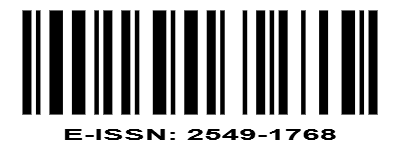MORPHOLOGICAL IDENTIFICATION OF WILD EDIBLE MUSHROOM (Termitomyces striatus) AT IPB UNIVERSITY CAMPUS FOREST
DOI:
https://doi.org/10.22373/biotik.v12i1.18170Abstract
Indonesia is a tropical country which is famous for its 2 seasons, namely the rainy season and the dry season. In the rainy season, the humidity level will increase and induce the development of mushroom’s fruiting body, including the edible kind. The research on wild edible mushroom diversity should be carried out massively in various regions in Indonesia. One of the potential areas is the forest area of the IPB University Campus (HKIU). This study aims to explore and identify wild edible mushroom in HKIU. The mushroom exploration was done using an opportunistic sampling method. Selected wild mushroom was obtained and identified for macroscopic and microscopic morphological characters. The identification results based on the morphological characters of the fruiting bodies indicated that the mushrooms obtained from the current study is Termitomyces striatus which is acknowledged as an edible mushroom. Our finding can provide the additional information on distribution of T. striatus in Indonesia and the potential of this mushroom cultivation in foreseeable future.
Downloads
References
Fauzan, Taribuka, J., & Patty, J. 2023. Eksplorasi Jamur Makroskopis di Kecamatan Leihitu Barat Pulau Ambon, Jurnal Agrosilvopasture Tech, 2 (1),78-84.
Wahyudi, T.R., Rahayu, S., & Azwin. 2016. Keanekaragaman Jamur Basidiomycota di Hutan Tropis Darata Rendah Sumatera Indonesia (Studi Kasus di Arboretum Fakultas Kehutanan Universita Lancang Kuning Pekanbaru), Jurnal Kehutanan, 11 (2).
Wu, B., Hussain, M., Zhang, W., Stadler, M., Liu, X., Xiang, M. 2019. Current Insights Into Fungal Species Diversity And Perspective On Naming The Environmental DNA Sequences Of Fungi. Mycology, 10 (3), 127–140.
Hyde, K.D. 2022. The Numbers of Fungi, Fungal Divers, 114 (1).
Naufal, M.A., Cici, A., Kusumawardhani, A.S., Sugiarto, A.Z., Fadila, D.S.R., Indraswati, F., Shalsabilla, S.E., Radiastuti, N., Fifendy, M. 2021. Identifikasi Makrofungi di Komplek Tumbuhan Suku Rubiaceae, Myrtaceae, dan Anacardiaceae Kebun Raya Bogor, Prosiding SEMNAS BIO, ISSN : 2809-8447.
Rahma, K., Mahdi, N., Hidayat, M. 2018. Karakteristik Jamur Makroskopis di Perkebunan Kelapa Sawit Kecamatan Meureubo Aceh Barat, Prosiding Seminar Nasional Biotik, ISBN: 978-602-60401-9-0.
Nurohmah, A., A’tourrohman, M., & Lianah. 2021. Biodiversitas dan Potensi Jamur Makroskopis di Cagar Alam Ulolanang Kecubung Batang Jawa Tengah. Seminar Nasional Biologi, Gunung Djati Conference, (6), ISSN: 2774-6585.
Putra, I.P. 2021. Panduan Karakterisasi Jamur Makroskopik di Indonesia: Bagian 1- Deskripsi Ciri Makroskopis, Jurnal Penelitian Kehutanan Wallacea, 10 (1): 25-37.
Pegler, D., & Vanhaecke, M. 1994. Termitomyces of Southeast Asia, Kew Bulletin, 49 (4): 717- 736. DOI: 10.2307/4118066.
Arif, A., Musrizal, M., Tutik, K., Vitri, H. 2007. Isolasi dan Identifikasi Jamur Kayu dari Hutan Pendidikan dan Latihan Tabo-Tabo Kecamatan Bungoro Kabupaten Pangkep, Jurnal Perennial, 3 (2).
Mahardhika, W.A., Utami, A.B., Lunggani, A.T., Putra I.P. 2022. Eksplorasi Jamur di Desa Kedung Pacul, Klaten dan Potensi Pemanfaatannya, Bioma, 24 (1): 8-23.
Ediriweera, AN., Voto, P., Karunarathna, SC., Dilshan, BC. 2023. Termitomyces srilankensis sp. nov. (Lyophyllaceae, Agaricales), a new species from Sri Lanka, MycolObs, 6: 47-53.
Heim, R. 1942. Nouvelles Études Descriptives Sur Les Agarics Termitophiles d’Afrique Tropicale. Archives Du Muséum National d’Histoire Naturelle, Série 6: 107–166.
Mossebo, DC., Njounkou, AL., Piatek, M., Ayissi, BK., & Djasbe, MD. 2009. Termitomyces striatus f. pileatus f. nov. and f. brunneus f. nov. From Cameroon with a key to central African species. Mycotaxon, 107, 315–329.
Koné, N.A., Soroa, B., Vanié Léabob , L.P.L., Konatéc, S., Bakayokoc, A., Koné, D. 2018. Diversity Phenology And Distribution Of Termitomyces species In Côte d’Ivoire, MYCOLOGY. 9 (4): 307–315.
Gomathi, V., M., Esakkiammal, S.S., Thilagavathi, A., Ramalakshmi, 2019. Lignocellulosic Enzyme Production by Termitomyces spp from Termite Garden, Universal Journal of Agricultural Research, 7(2): 100-111, DOI: 10.13189/ujar.2019.070202.
Li, Y. 2018. Determination of Water Soluble Vitamins in Black Termitomyces spp. by High Performance Liquid Chromatography. Food Research and Development, 39 (17): 124 128.
N. A. Teke, N.A., Kinge, T.R., Bechem, E., Nji, T.M., Nda, L.M., Mih, A.M. 2018. Ethnomycological study in the Kilum-Ijim mountain forest, Northwest Region, Cameroon. L, Journal of Ethnobiology and Ethnomedicine, 14:25, https://doi.org/10.1186/s13002 018-0225-8.
Hsieh, H.M., and Ju, Y.M. 2018. Medicinal components in Termitomyces mushrooms, Applied Microbiology and Biotechnology, 102 (12): 4987−4994, https://doi.org/10.1007/s00253 018-8991-.8.
Published
Issue
Section
License
Authors who publish with BIOTIK: Jurnal Ilmiah Biologi Teknologi dan Kependidikan agree to the following terms:
- Authors retain copyright and grant the journal right of first publication with the work simultaneously licensed under a Creative Commons Attribution License that allows others to share the work with an acknowledgement of the work's authorship and initial publication in this journal.
- Authors are able to enter into separate, additional contractual arrangements for the non-exclusive distribution of the journal's published version of the work (e.g., post it to an institutional repository or publish it in a book), with an acknowledgement of its initial publication in this journal.
- Authors are permitted and encouraged to post their work online (e.g., in institutional repositories or on their website) prior to and during the submission process, as it can lead to productive exchanges, as well as earlier and greater citation of published work.











